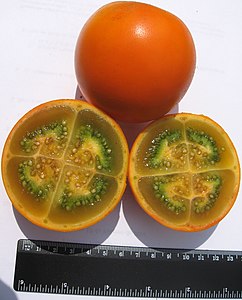What does Solanum quitoense mean?
Definitions for Solanum quitoense
solanum quitoense
This dictionary definitions page includes all the possible meanings, example usage and translations of the word Solanum quitoense.
Princeton's WordNet
naranjilla, Solanum quitoensenoun
small perennial shrub cultivated in uplands of South America for its edible bright orange fruits resembling tomatoes or oranges
Wikipedia
Solanum quitoense
Solanum quitoense, known as naranjilla (Spanish pronunciation: [naɾaŋˈxiʝa], "little orange") in Ecuador, Costa Rica, and Panama and as lulo ([ˈlulo], from Quechua) in Colombia, is a tropical perennial plant from northwestern South America. The specific name for this species of nightshade means "from Quito."The lulo plant has large elongated heart- or oval-shaped leaves up to 45 cm in length. The leaves and stems of the plant are covered in short purple hairs. Naranjilla are delicate plants and must be protected from strong winds and direct sunlight. They grow best in partial shade. The fruit has a citrus flavour, sometimes described as a combination of rhubarb and lime. The juice of the naranjilla is green and is often used as a juice or for a drink called lulada.
ChatGPT
solanum quitoense
Solanum quitoense, commonly known as naranjilla or lulo, is a subtropical perennial plant from the Solanaceae family, native to South America. The plant is recognized by its large, heart-shaped leaves and produces small, round, edible fruit with a citrus-like flavor. It is typically used in making juice or jelly, and is grown for commercial use mostly in Colombia and Ecuador.
Matched Categories
Numerology
Chaldean Numerology
The numerical value of Solanum quitoense in Chaldean Numerology is: 3
Pythagorean Numerology
The numerical value of Solanum quitoense in Pythagorean Numerology is: 4
Translation
Find a translation for the Solanum quitoense definition in other languages:
Select another language:
- - Select -
- 简体中文 (Chinese - Simplified)
- 繁體中文 (Chinese - Traditional)
- Español (Spanish)
- Esperanto (Esperanto)
- 日本語 (Japanese)
- Português (Portuguese)
- Deutsch (German)
- العربية (Arabic)
- Français (French)
- Русский (Russian)
- ಕನ್ನಡ (Kannada)
- 한국어 (Korean)
- עברית (Hebrew)
- Gaeilge (Irish)
- Українська (Ukrainian)
- اردو (Urdu)
- Magyar (Hungarian)
- मानक हिन्दी (Hindi)
- Indonesia (Indonesian)
- Italiano (Italian)
- தமிழ் (Tamil)
- Türkçe (Turkish)
- తెలుగు (Telugu)
- ภาษาไทย (Thai)
- Tiếng Việt (Vietnamese)
- Čeština (Czech)
- Polski (Polish)
- Bahasa Indonesia (Indonesian)
- Românește (Romanian)
- Nederlands (Dutch)
- Ελληνικά (Greek)
- Latinum (Latin)
- Svenska (Swedish)
- Dansk (Danish)
- Suomi (Finnish)
- فارسی (Persian)
- ייִדיש (Yiddish)
- հայերեն (Armenian)
- Norsk (Norwegian)
- English (English)
Word of the Day
Would you like us to send you a FREE new word definition delivered to your inbox daily?
Citation
Use the citation below to add this definition to your bibliography:
Style:MLAChicagoAPA
"Solanum quitoense." Definitions.net. STANDS4 LLC, 2024. Web. 23 Apr. 2024. <https://www.definitions.net/definition/Solanum+quitoense>.



Discuss these Solanum quitoense definitions with the community:
Report Comment
We're doing our best to make sure our content is useful, accurate and safe.
If by any chance you spot an inappropriate comment while navigating through our website please use this form to let us know, and we'll take care of it shortly.
Attachment
You need to be logged in to favorite.
Log In